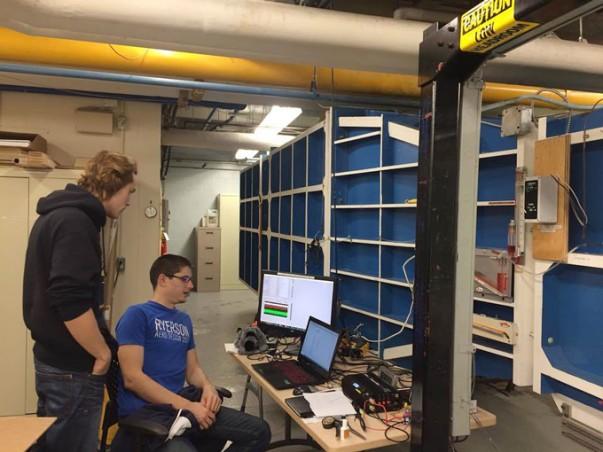By Bradly Shankar
For 30 years, Ryerson has been sitting on an engineering goldmine, and now it’s finally starting to pay off. Renovations have wrapped up after one year of work on the university’s own fully-functioning wind tunnel.
A wind tunnel is large tube filled with an air current that is used to copy the actions of an object in flight. Students helped modify the tunnel, which now has an external motor drive and can run for continuous periods of time without overheating.
“Before, we could only run the wind tunnel for about 10 minutes,” Ryerson aerospace engineering professor Goetz Bramesfeld said. “Now, it can run smoothly all day long.” He said that this allows for easier testing of small unmanned aerial vehicles (UAV).
Bramesfeld said that many people believe digital programs can be used in place of the wind tunnels, which are sometimes seen as outdated. But thanks to his experience with wind tunnels from various educational institutions, he said he knew this wasn’t entirely true. “Wind tunnel testing allows us to take data much more quickly and to make sense of it more easily.” He hoped to introduce a more powerful wind tunnel to Ryerson when he began working at the university in 2013. “I noticed that the tunnel here was a very good resource with a strong basis present, but unfortunately was a little neglected over the years,” Bramesfeld said.
After pitching the idea to colleagues, he made a proposal to the university with backing by Paul Walsh, the chair of the aerospace engineering department.
Ryerson provided $80,000 in funding to a team of approximately 20 people. While the bulk of more sophisticated engineering was handled by outside contractors, there were several undergraduate and masters students working on the project as well. In addition to the motor drive work, students have been regularly performing check-ups on the tunnel and repainting it. Bramesfeld, Walsh and a technical officer who was directing the renovation spearheaded all of the work.
Among those involved is Tim Carroll, a masters of applied science candidate in aerospace engineering. For him, the project has been a great learning experience essential to his degree. “This is something that if we didn’t have, I wouldn’t be able to do my thesis,” he said.
Carroll said wind tunnels aren’t readily accessible to most organizations outside of a select few private companies. Because of this, the university has seen a lot of industry interest from institutions looking to experiment with wind tunnels. This opens up many opportunities for the university to create partnerships with different technological companies.
According to Carroll, the future of aerospace is primarily in the development of devices like UAVs. With Ryerson’s own wind tunnel currently assisting companies with aerospace engineering, the university can be at the forefront of these advances.
An official opening for the tunnel is set for Nov. 19. The aerospace engineering department then plans to introduce it into the curriculum.










Leave a Reply